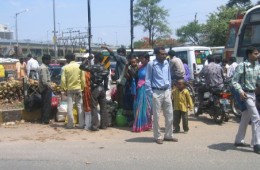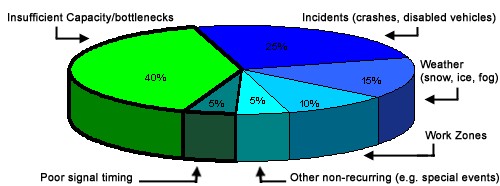How many times have you heard someone say, "Building this flyover has made the traffic situation worse, not better"? If you live in any of the major metropolitan areas, I suspect you've been within earshot of that view - or even expressed it yourself - quite often. All sorts of reasons are furnished - lack of land allotment, inadequate enforcement, bad design of the flyover itself, etc. Being a transport planner, I wondered about some of the reasons offered, and came up with two key explanations of my own. I decided to test my hypothesis, by making some observations of my own.
I visited two locations - first, the Silk Board junction in Bangalore (intersection of Hosur road and Outer Ring Road), which is the gateway to Electronic City southeast of the metropolis, and second, the flyover on Western Express Highway in Andheri, Mumbai (formerly known as the Goldspot Junction). At both locations, I found the same two issues that I suspected had never been considered during any stage of the design and construction - high pedestrian traffic, and stops made by outstation and other private buses. These problems are also a common feature, I am sure, of virtually any flyover in the peripheral neighbourhoods of all cities; a singular 'engineering' mentality to design and construction has resulted in grand structures, but these don't appear to have solved the underlying problems that prompted their construction.


Two lanes of traffic get clocked when buses stop at junctions near flyovers to allow passengers to board or disembark. Also, passengers - many struggling with luggage too - have no designated places to cross the junctions, either, and simply walk into the traffic stream instead. |
High pedestrian traffic
It has become commonplace for transport authorities to consider roads the rightful space of vehicles alone, especially faster moving vehicles. This is a view prompted largely by how roads are used in developed countries, and partly by class - the needs of higher income road users in private vehicles are prioritised over the needs of the great many who can't afford even the most basic mechanised transportation. Perhaps these will change someday. But today's reality is that pedestrian traffic on the streets is a reality. Any design for improvement, therefore, must first acknowledge this, and plan for it. Since observing the two flyover locations mentioned here, I have continued to notice the complete apathy of engineering design for pedestrians. Not a single roadway, junction, signal, flyover is geared or designed to handle the high pedestrian volume. But ignoring pedestrian traffic does not make it go away; it simply makes the rest of the planning pointless.
Engineering design cannot be exclusive for motor vehicles. It needs to be inclusive and equitable. A "Pedestrian Circulation Plan" should be mandated in every engineering design. Citizen groups should insist on a seeing the pedestrian circulation plans for each junction improvement effort before construction begins. Existing pedestrian volumes at the junction should be assessed and a plan to service these pedestrians without hindering their safety and flow of motor vehicle traffic should be developed.
Administrators argue that pedestrian walkways/subways are rarely used by citizens habituated to walking into the traffic stream to cross roads. But the response here should not be to throw away the pedestrian plans; instead better enforcement of pedestrian use of the pedestrian pathways that have been built should be taken up. Bad habits need to be broken, but this takes time and commitment from planners and implementors alike. During the initial days of an implemented pedestrian circulation plan there should be three policemen maning a location, not just one lone officer.

•
Emphasis on mixed use needed
•
Ahmedabad takes the bus
•
Walk on the road, legally
Outstation and other private buses
Most outstation-bound buses, as well as company buses run by large employers stop at junctions to drop off and pick up passengers. These are typically the locations where flyovers are built. Very often, people walk across a busy traffic stream or queue up at corners of the junction. These include outstation travellers transferring to a local bus (or the reverse), workers transferring to a company bus, citizens from nearby villages trying to reach markets in the city, and so on. Since the junction itself is not planned with these needs in minds, inevitably chaos results.
The solution is not to ban or prevent these vehicles from stopping at these locations, for they are providing an unparalleled service. instead, the response must be inclusive, by developing designated stopping areas in the vicinity of the junction. Necessary infrastructure should be built to allow passengers to transfer to local buses or other modes (auto rickshaw, taxi). Again enforcement is unavoidable, and has to be honest and equitable to all service providers. Violating the norms for planned usage - such as stopping in mid-traffic to pick up a few extra passengers before the competing bus company can get to them - has to attract a significant penalty that deters such violations. Government-operated transport services, especially unionised ones whose drivers don't feel particularly obliged to obey traffic policemen, should simply be segregated into designated bays, so that the process itself ensures compliance with traffic rules.

Only 40 per cent of congestion on the roads is from insufficient road capacity and bottlenecks, according to a recent study by
the FHWA in the US.
A recent research paper from the Federal Highway Administration in the United States concluded that 60 per cent of the traffic congestion is non-recurring - i.e. this congestion is caused by something other than insufficient capacity and bottlenecks. This chart tells us the story - more than half the problem is not due to lack capacity, but lack of capacity management, which results from ignoring and neglecting important issues. In Indian conditions, the lack of pedestrian, bicycle and informal public transport (auto rickshaws, taxis and private buses) management contributes to more than 30 per cent of the traffic congestion. Simply improving the management of these can result in savings of time - and money that would otherwise be sunk into even more grand engineering plans.
The actual conditions of road use should form an important core of traffic and transport plans. Citizens can do their part too, by asking for pedestrian circulation plans at future construction locations, and by complying with administrators' efforts at reorganising public spaces for better uninterruped movement.























